John Hurrell – 8 June, 2015
These rippling buckled sheets of ultra glossy paper look strangely like thin, burnished copper, bronze or at times gold - that from some angles seem tarnished with a dirty oily film to introduces a vague iridescence. The optically variable surface is extraordinarily subtle, and depends greatly on the source and direction of the ambient light. The natural variety is far better than electrical for seeing the detail in the marks, though artificial may introduce a wider chromatic range.
As part of the evolving process of growing interaction between Australian and Aotearoa New Zealand art communities, this new Fox Jensen exhibition introduces a young Australian artist who was recently given the award for Best Emerging Artist in the 2015 Redlands Konica Minotta Art Prize.
For his first exhibition here, Coen Young presents a baker’s dozen paintings on paper that have been framed and put under glass. They feature a process that causes their surfaces take on the voluptuous sheen of mirrors, created by brushing on a sequence of layers. The substances in order are gesso, black enamel, marble dust, and then silver nitrate, that top layer becoming activated by the addition of water to darken when left over time. It is finally fixed with acrylic resin when a deepening tone is finally attained that is desired by the artist.
These rippling buckled sheets of ultra glossy paper look strangely like thin, burnished copper, bronze or at times gold - that from some angles seem tarnished with a dirty oily film to introduce a vague iridescence. Young‘s optically variable surface is extraordinarily subtle, and depends greatly on the source and direction of the ambient light. The natural variety is far better than electrical for seeing the detail in the marks, though artificial may introduce a wider chromatic range.
If you let your eyes adjust and scrutinise the dark evanescent surfaces you soon find the works are quite individual, with different vertical and/or horizontal patterns of striations, shoals of flecks, randomly scattered knotlike pits (as if in tar) and wisps of dribbly asymmetrical stains. Sometimes the intricate linear configurations are not uniform but on one half - or one side - of the vertical paper rectangle, and not the other.
All these of course are competing with the dominant, undulating, mirrored sheen - and consequently can initially only be detected with difficulty. The resisting silvery surface and blackish (almost green) hues look like a combination of a dense graphite drawing and a fairground mirror with the reflective surface of a daguerreotype.
It is this graphitelike quality that really intrigues: works made by brushing on (a painting method) to paper (a drawing support). They look unnervingly like very very dense, shiny pencil drawings with horizontal graphite lines. There is the fascination, the paradox. We see none of the matte flatness of acrylic wash or the abruptly choppy - but smudgy - sheen of oil paint; confused further by the overlaid glass and your own reflection peering in. The manuality (and how the marks are to be interpreted) is puzzling - and this is what draws you in.
John Hurrell
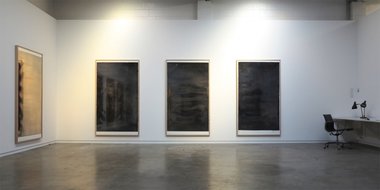
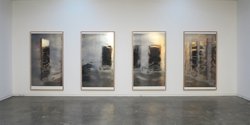

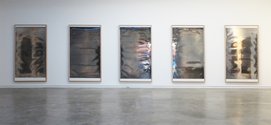

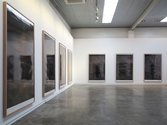
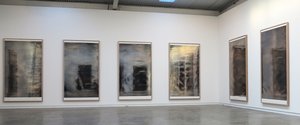
 Advertising in this column
Advertising in this column Two Rooms presents a program of residencies and projects
Two Rooms presents a program of residencies and projects



This Discussion has 0 comments.
Comment
Participate
Register to Participate.
Sign in
Sign in to an existing account.